Last Updated on March 11, 2022 10:55 pm
Introduction
SSD’s have come down in price over the last decade substantially. So much so that they have pretty much displaced laptop hard drives as the de facto storage device. The 2.5″ 7mm thick form factor limited hard drive capacities to 2TB, and while newer hard drive technology could likely improve that capacity, the cost of a 2TB SSD isn’t substantially more than a 2TB laptop hard drive, and whatever price increase exists, that is easily justified with the significant increase in performance you’d get from an SSD. That being said 2TB SSD’s can still run around $200 USD price range (March 5, 2022), so still a hard pill to swallow.
One should always be leery about low cost SSD’s, however, since many don’t use DRAM cache and/or use barebones components that can make your SSD slow to a crawl that a laptop hard drive could easily outperform. But sometimes you just want a large capacity average performing SSD to store your crap. I was in this position just recently and came across the Leven brand SSD’s on Amazon which were considerably cheaper than comparable recognized name brand solid state drives. $145 for 2TB SATA Leven JS-600 SSD which I decided to scoop up.
Construction
There’s not much to say about the SSD other than it is in a metal housing with a plain sticker indicating model JS-600 with no clear indication of capacity. On the back is a barcode for part number and serial number and associated text. It’s a typical SATA connector and had no issue plugging it in and being recognized in Windows. I did have to activate it in Windows Disk Management and create a new partition, however, before I could use it. This is pretty common with bare drives.
I wanted to open up the device to see the guts, check out what controller it is using, but it seems pretty well sealed and no clear way to open it up without risk of damaging the casing. If I figure it out I’ll do so and post images here.
Capacity
As noted this is a 2TB capacity SSD. Actual usable space in Windows is 1.86TB or 2,048,390,066,176 bytes.
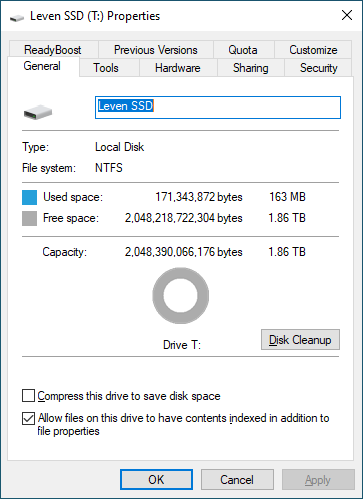
Performance
I ran the SSD through a few tests to validate its performance capabilities:
CRYSTALDISKMARK:
This test is pretty standard fare for hard drives and SSD’s alike. It provides a good general figure of large file sequential performance as well as small file performance. Small files are always have lower read and write performance compared with larger sequential ones, but SSD’s generally do it much faster overall than a hard drive.

You can see that sequential read and write are around 500 MB/sec, which is reasonable for a low end SSD. Well above a hard drive which usually caps out at around 200 MB/sec for a desktop drive and 150MB/sec or so for a laptop hard drive. The random 4K small file test with a deep queue depth of 32 performs surprisingly well at 220 MB/sec read and 158 MB/sec write, with single queue depth of Read performance of 34 MB/sec and Write at 88 MB/sec. Overall it looks like a reasonable SSD.
FILE COPY TEST:
While the CrystalDiskMark results look promising, a short benchmark doesn’t always tell the whole story. So I have my own file copy test script that simply generates a 1GB file of random data on the fly, copies that file to the test disk, and calculates and logs the time it takes to copy each file. So I set up the script to run a full disk file copy test of 1GB files, 1800 files in total which will all but fill the SSD to its maximum capacity.
Write Performance:
A nonstop write to the entirety of storage space of an SSD is a brutal test, that even top end SSD’s would likely falter. But it does give a more realistic expectation of performance for the disk. This first write test was run on a fresh disk, just out of package, so it should be best case performance overall.

You can see that it starts out writing at about 400-460MB/sec. At about 500GB of writes the performance just tanks and oscillates between about 40MB/sec and up to 400 MB/sec. It eventually stabilizes back at 400MB/sec and then finally goes back to oscillating between 40MB/sec to 400 MB/sec. This may look bad, but overall I’m impressed it was able to make it through about 500GB of writes before performance tanked.
Temperature sensor on the SSD never exceeded 36C so it doesn’t appear to be temperature related.
Since I was curious why the performance tanked like it did, I considered that perhaps it needed some time for the controller and NAND to keep data in order. So I updated the script to pause writes for an hour after 400GB of data written, then continue for another 400GB, etc, to perhaps give the SSD some time to do any “garbage collection” routines before hitting it up again with additional writes.
Before starting the benchmark again, I did delete the partition on the SSD, created a new one, TRIMMED the drive, and let it idle for 12 hours. This should be enough to let it refresh it back to normal.
The 1GB File WRITE Test with 1 HR pause every 400GB Written resulted in the following:
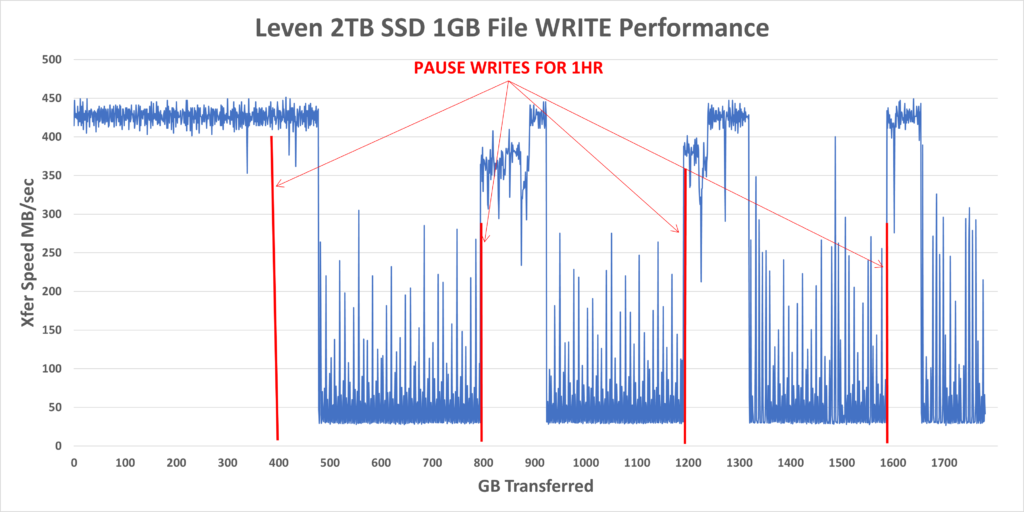
It did not fare much better, but it seems the pause allowed the SSD to breathe a bit to help bring back performance for a little while before tanking again.
Since the 1 hr pause seemed to help, I increased the pause interval to four hours. The SSD partition was formatted and TRIM’d and let idle powered on for 24 hours before starting the next test to allow the SSD to “heal” whatever might be plaguing it after extended writes.

I am not sure what to make of this. It doesn’t appear to have improved much at all. It looks very similar to the 1 hr idle interval. Although after each pause interval it seemed to have some sort of positive effect to the write performance.
One wild theory is that there are two types of storage on this SSD. 500GB of NAND with reasonably fast write performance, and then that data is offloaded to much slower NAND over time, so future writes are always on the 500GB of fast NAND. So effectively one large NAND cache that offloads to NAND that has pitiful write performance but reasonable read performance, as you’ll see below, read performance is consistent across the entire SSD.
Further testing, I wrote 200GB with 2 hour pause intervals in between:
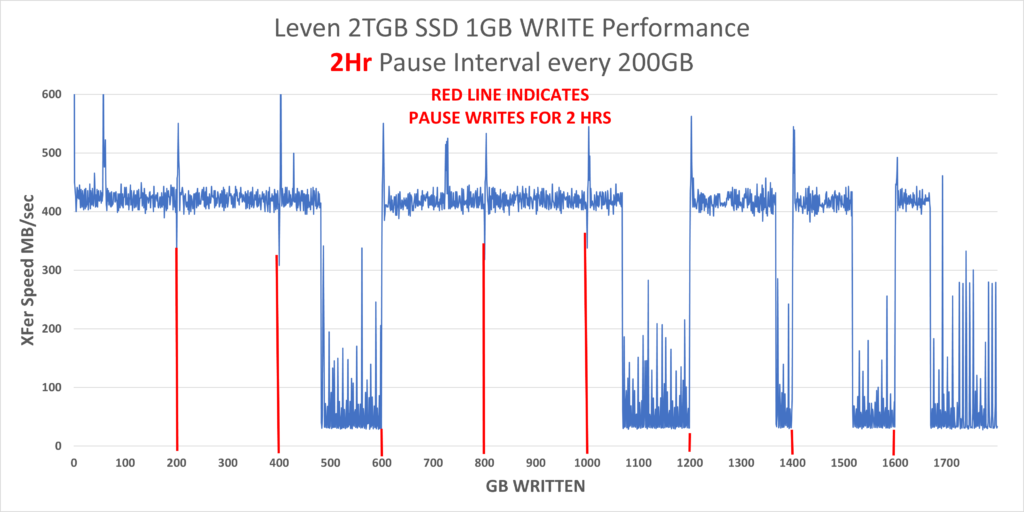
The time delay seemed to improve performance somewhat, but still had several locations of slow writes.
Next step is a 4 hour pause every 200GB:
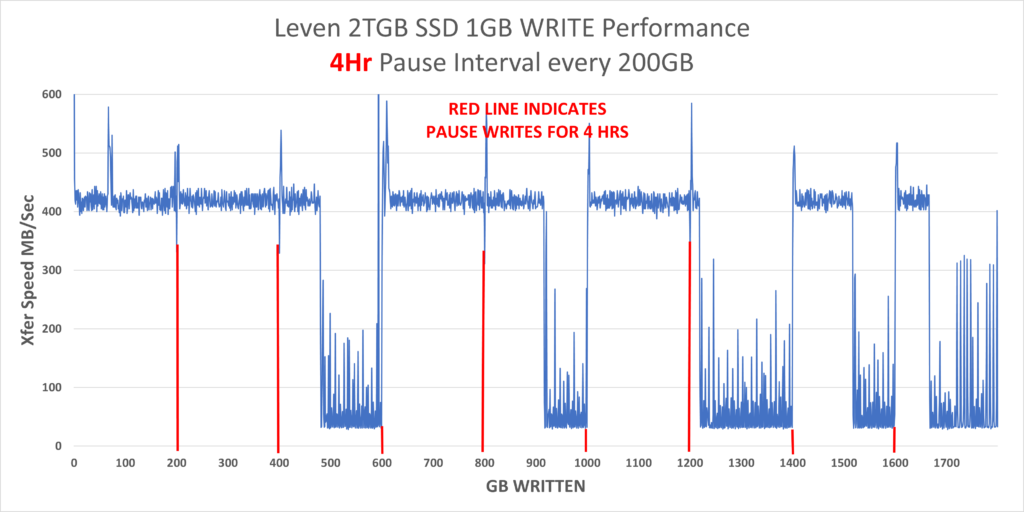
This didn’t seem to improve matters a whole lot. The delay seemed to improve performance for a slight bit, but still dropped down to a miserable 30-50 MB/sec on average.
So I decided to try one last ditch effort. Over-provisioning the SSD by 20% (400GB on 2TB drive) with 4 hour idle time every 200GB written. Over-provisioning an SSD is basically giving the SSD additional space to manipulate data with its garbage collection routine. It can help improve performance in general as well as extend the life of an SSD. In this case the disk was over-provisioned, executed TRIM command, and let idle for 24 hours before commencing the test.
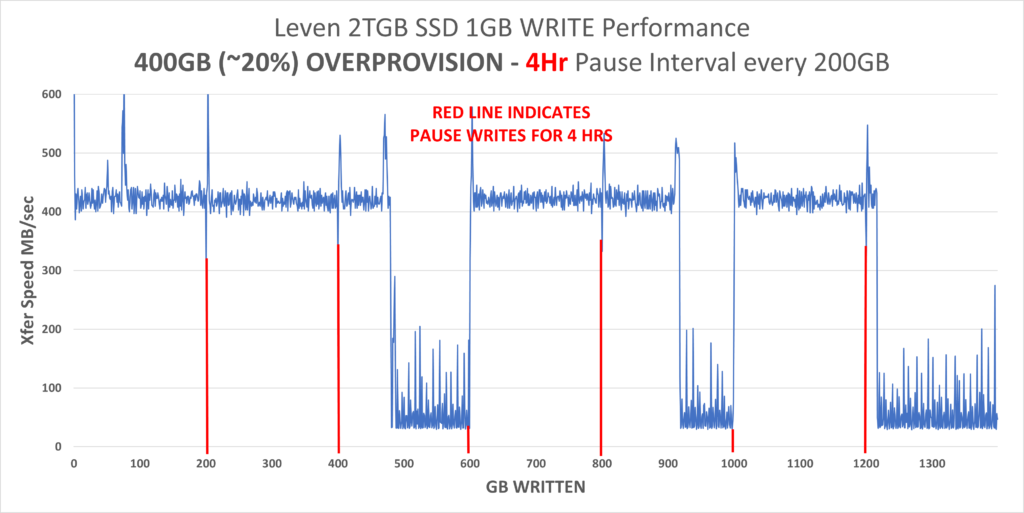
Even with Over-Provisioning nothing can seem to keep this drive operating at peak performance. Maybe 200GB in one go is too severe, but that shouldn’t be too much to ask of an SSD, even a lower end one.
I thought perhaps my specific SSD was defective, so I exchanged it through Amazon and achieved largely the same results as the first SSD.
So it appears that with any amount of extended writes to the SSD, one should expect a significant performance drop at some point. 100-200MB/sec would be almost acceptable, but the 30-50MB/sec it drops to is less than even what a USB hard drive can offer.
Read Performance:
After writing to the disk for the first benchmark, I performed a read test similar to the write test. I copy the file from the SSD to a RAMDISK so that destination write performance is not a factor. After the files are copied to RAMDISK, they are subsequently immediately deleted from RAMDISK, because I don’t have 2TB of RAM to spare, LOL.
Here are the 1GB READ performance results:
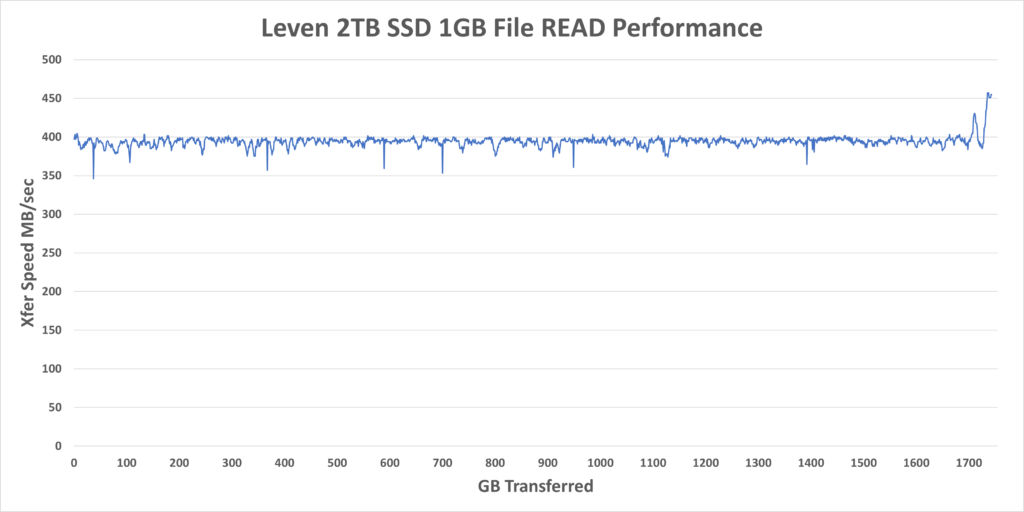
It is pretty clear that it offers a consistent 400 MB/sec file read/copy performance across the entire disk.
Conclusion
The Leven JS-600 2.5″ 2TB SSD is a decent deal if you can nab it for about $150. It’s really more an SSD for mass storage that offers consistent 400MB/sec read performance across the whole disk, which is at least twice the performance you’d get from a laptop hard drive, not to mention the vastly improved 4k random read and writes.
Its write performance is consistent at about 400MB/sec up to 500GB of constant writes. After that, performance will tank. We can see that given enough idle time it will correct itself somewhat, but not completely. It’s forgivable if an SSD performance is reduced somewhat after continuous writes, but even given time to correct itself, the write performance dropping to 30-50 MB/sec of this Leven 2TB SSD is abysmal.
It’s difficult to really see what this drive would be good for. I wouldn’t consider this drive if you’re looking for something to record video footage regularly for YouTube or other social media, because you may lose video frames. Even as a Steam game drive it might work, but issue is that when Steam updates data, it does a lot of writes, and it may take an exhaustively extended period just to update a game.
Bottom line, it’s a budget SSD that would work great for general purpose data storage that is primarily read from not written to.
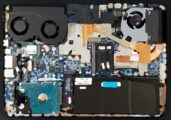
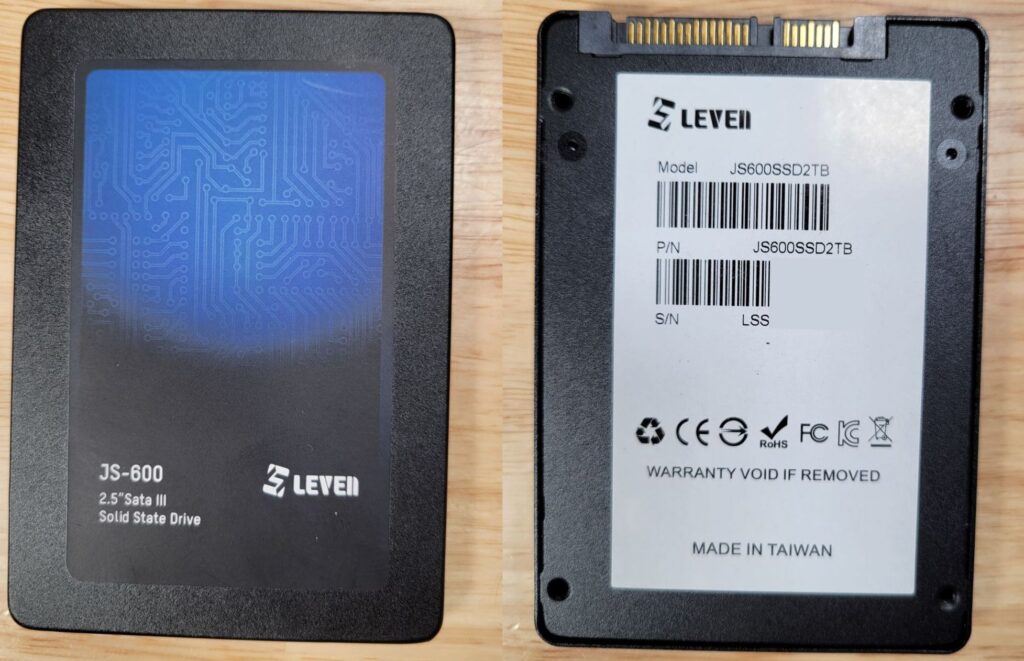
Hello, first thanks for the review for the Leven 2TB unit. It was informative in highlighting the shortcoming of DRAM-less SSDs, although I very much disagree with your methodology and your conclusion therefrom.
Where I’m coming from: Like you, and presumably many others, I’m always on the lookout for “good but cheap” tools, be they electronics or whatever. DRAM-less SSDs are first on the docket as I’m upgrading some old PCs. I read your two reviews related to the Leven 2TB and subsequent 256GB (DRAM) units and would like to comment.
You said it yourself, that your “whole drive write copy” is a “brutal” test. Which should obviously mean that it is very much atypical, or even nonsensical, as the only time your use case would be applicable is for drive-to-drive imaging, which again is atypical. To sum, you didn’t test the drive for typical use.
Your conclusion, however, is wildly overreaching, when you state that it’s “not really good for anything” (paraphrasing), including typical uses you never test for.
A typical use obviously varies, but a 500GB-write-before-drop-off that the 2TB unit allows should well cover most such uses. The question I have, which you didn’t adequately test for (other than to pause between writes), is what are the criteria that allows the unit to recover its write speed. As you found, pauses help somewhat. Would running a TRIM periodically (which Windows does automatically weekly) help further? I don’t know, but I will test for that, as I’ve bought some low-end DRAM-less SSDs for abovementioned upgrade.
To sum, your piece on this is informative to be sure, but it is regretable that it is misleading, to imply that basically all DRAM-less SSDs aren’t “good for anything” and one should buy more expensive DRAM units.
To end, I sincerely wish you and yours to have a happy holiday. I regret that my post is contentious in tone, but that’s the strongest motivation for posting, isn’t it, when we disagree with something? In any case, cheers and good computing.
Hoang
VERY INTERESTING METHODOLOGY B R A V O !!!
This is the first annoying thing, about big file transfer we all want to know but no one test it and we only see this stupid crystal disk bench absolutely insane and useless.
You test it with continuous “brutal non stop” write and this is what EVERY BRAND MUST SHOW US BEFORE TO SELL THEIR DISK FOR A VERY EXPENSIVE PRIVE.
Thanks for that sincerely
Thanks for the response. It’s a bit brutal of a test because I don’t think most users use it that way, but it is indicative of it’s actual performance.